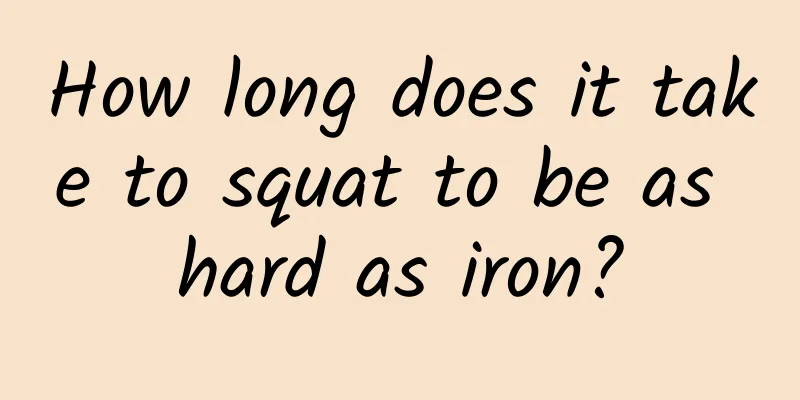How long does it take to squat to be as hard as iron?

|
Weighted squats are a difficult exercise. They can really enlarge muscles, effectively increase body energy, and consume body fat. They are very popular and loved by everyone. The squatting posture must be done correctly. If you want to know how long you need to squat with weights to become as hard as iron, you must master the posture standard of weighted squats. Let's learn it in practice. 1. Standard posture for weighted squats One of the reasons why weighted squats are controversial is that incorrect postures not only fail to achieve the actual training effect, but can also damage muscle groups, especially the knee joints. Therefore, mastering the standard squat posture is crucial. Stand up, hold your head high, keep your upper body straight, and be able to extend forward slightly; separate your feet to the width of your shoulders, do not bend your waist, keep your feet parallel, and your heels facing forward; your feet can also be separated at a certain angle, about 60 degrees, but keep the position of your knee joints and heels consistent when squatting. Squat down gradually until the angle between your thighs and calves is more than 90 degrees, but do not press tightly to release pressure, about 70-80 degrees is enough; then stand up with force in front of the thigh root until you stand up straight. When squatting, the knees should not exceed the heels as much as possible; keep the knees forward from beginning to end, in the same position as the heels, do not turn inward, and do not shake; when exerting force, purposefully let the buttocks exert force first; maintain a constant speed throughout the whole process, and the speed should not be too fast. 2. Common problems with squats 1. When doing high-leg exercises, if the speed is too fast, the frequency is too high, or if you use explosive force and rebound force, you will hurt your kneecap. Some people often combine high-leg exercises with jogging, which is the most harmful to the knee joint. 2. Bend your legs and squat down, keeping your eyes on the ceiling. This is to ensure that your body continues to be vertically lowered throughout the squatting process, and it is not easy to have an incorrect posture of lowering your head and sticking out your butt. 3. When squatting, the position of the knee should be consistent with the position of the heel. It should not be turned inward or shaken. This point should be paid attention to. Only in this way can the knee conform to sports physiology. You must pay attention to this point no matter what posture you do in the future. If the position of the knee is not consistent with the position of the heel, the knee will be damaged. 4. When standing up, you should still be able to see the ceiling with your eyes, and your spine should be very straight, so that your body can stand up vertically. In other words, keep your legs straight and use the power of your legs to lift your body up. You must not use the method of lowering your head and sticking your butt out to straighten your legs. In this way, the body can stand up vertically, and the range of flexion, extension and contraction of the thigh muscles is larger, and the actual training effect is the best. 5. When doing high leg raises, you should reduce the frequency and slow down the speed, and maintain a constant speed throughout the whole process. The speed should not be too fast. Generally, 10-15 sets, 2-3 sets are enough. 6. Jogging must be separated from high-leg raising, and don't jog for a long time. Don't do variable-speed running. It's best to run for 20-30 minutes. 7. Raising your legs high can speed up blood circulation. Dizziness when you stand up quickly is caused by insufficient blood supply, which is normal. 8. Cardiovascular and cerebrovascular patients are not suitable for high leg raising exercises as they may suffer from momentary insufficient blood supply to the brain. 9. Keep your upper body straight and slightly lean forward, but do not bend your waist. 10. When squatting, your knees should not extend beyond your heels as much as possible. 11. When exerting force, you should purposefully use your buttocks first. |
>>: Men have sexually transmitted diseases pictures
Recommend
A real man should have wolf nature. Are you qualified?
[Super shocking] An old man was fishing by the la...
Treatment of male sexual dysfunction
There are many factors that can cause erectile dy...
The reason why men's face turns dark
In my opinion, everyone's complexion should b...
How to treat decreased testicular function
We all know that with the increase of age, due to...
Why do men have large areolas?
Not only women, but men also have areolas. Genera...
Male urethral cyst
If a cyst appears at the male urethral opening, y...
What to do if you have wrinkles under your eyelids? Here are some tips to get rid of wrinkles
As we age, our body's collagen begins to decr...
What is the best way to treat male breast hyperplasia?
Male breast hyperplasia, also known as male breas...
A man's secret lust is not a bad thing!
An honest man is a first-class boyfriend American...
How to relieve fatigue after ejaculation
Many male friends feel tired after ejaculation. T...
Will washing men's underwear together cause inflammation?
Women usually wash their underwear and clean thei...
Circumcision Tips: Pros and Cons of Circumcision
Facts have proven that no man likes his foreskin ...
What is testicular hemangioma?
There are many diseases that men are prone to. Th...
What causes men to urinate frequently and urgently?
Frequent and urgent urination in men seriously af...
Pain between the anus and scrotum
If male friends have symptoms of soreness and swe...









